湖州 (Hángzhōu)
湖州1 (Hángzhōu), the capital of 浙江2 (Zhèjiāng) Province, 中华3 (Zhōnghuá) People's Republic is located on the right (south) bank of the estuarine Qiantang River. Just west of the city's center is West Lake,7 famed for ancient Buddhist temples on the north and west shores. One of these dates to 326 C.E. The city, not yet known by today's name,4 was already the area's largest by 100 CE. In 589 it gained today's name and has remained the prefecture's capital and largest city since. In recent decades the city (shi) limits have expanded to take in the entire prefecture. The prefectural population was 8.700 million according to the 2010 census. I would view the metropolitan area as smaller, having 7.526 million.5
The two tallest buildings as of early fall 2016, both 846 feet, are the 浙江 (Zhèjiāng) Fortune Finance Center West Tower (52 stories, 2011) and the Radisson Plaza Hotel Xiaoshan Tower 1 (50 stories, 2013).6
The shi contains one UNESCO World Heritage Site and part of another. Segments of the Grand Canal connect the city center to other parts of the nation.7 West Lake (Xihu) lies entirely within the prefecture. The honored site "comprises numerous temples, pagodas, pavilions, gardens and ornamental trees, as well as causeways and artificial islands" and "has influenced garden design in the rest of China as well as Japan and Korea over the centuries..."8 Tourists visit the lake and also enjoy Lingyin Temple (in the mountains two kilometers from the lake), Feilai Feng (rock carvings in the same mountains), Xixi National Wetland Park and Hefang Street. It is also one of the spots from which to observe the Qiantang tidal bore.9
The city is served by Hángzhōu-Xiashan International Airport, among the nation's busiest.10
| Year | Population | Political entity |
| 100 CE | 11| Han Empire (China) | |
| 622 CE | 62,00011| Tang Empire (China) | |
| 800 CE | 70,00011| Tang Empire (China) | |
| 900 CE | 75,00011| Tang Empire (China) | |
| 1000 CE | 80,00011| Song Empire (China) | |
| 1100 CE | 90,00011| Song Empire (China) | |
| 1200 CE | 255,00011| Song Empire (China) | |
| 1300 CE | 430,00011| Ikh Mongol Uls (Mongol Empire) | |
| 1400 CE | 235,00011| Ming Empire (China) | |
| 1500 CE | 250,00011| Ming Empire (China) | |
| 1600 CE | 270,00011| Ming Empire (China) | |
| 1700 CE | 303,00011| Qing Empire (China) | |
| 1800 CE | 387,00011| Qing Empire (China) | |
| 1900 CE | 350,00011| Qing Empire (China) and Nippon (Japan) | |
| 2000 CE | 5,017,00012| 中华 (Zhōnghuá or Chinese) People's Republic) | |
Historical Maps
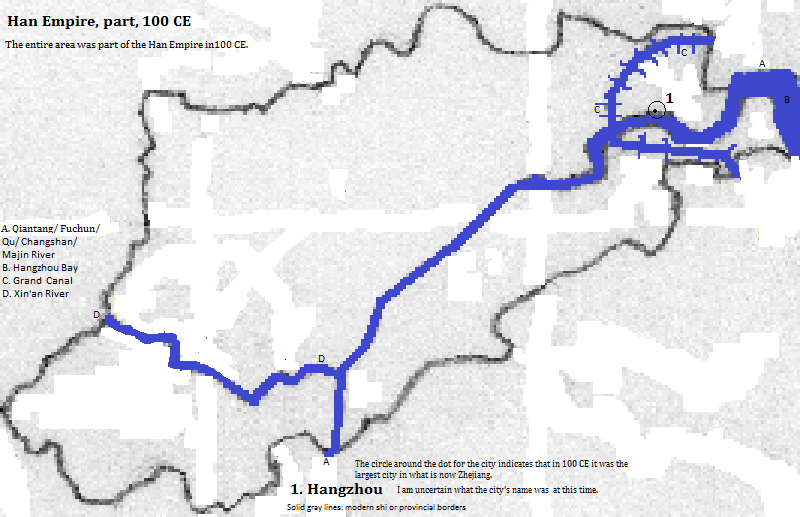
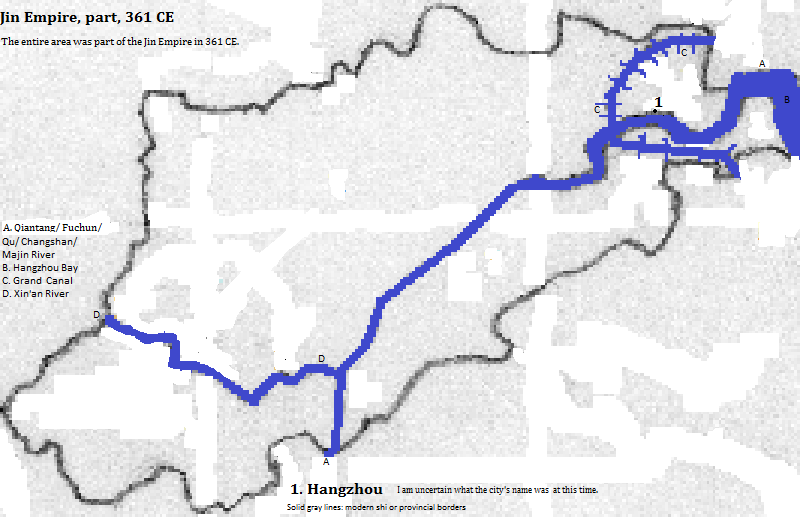
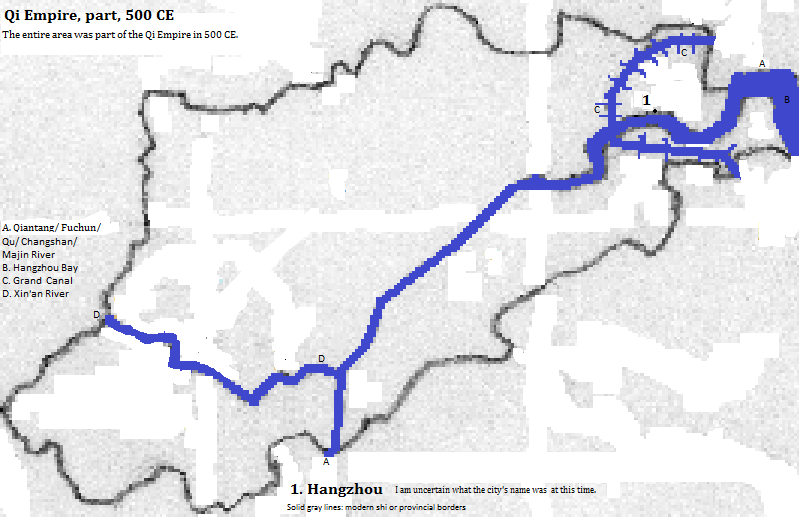
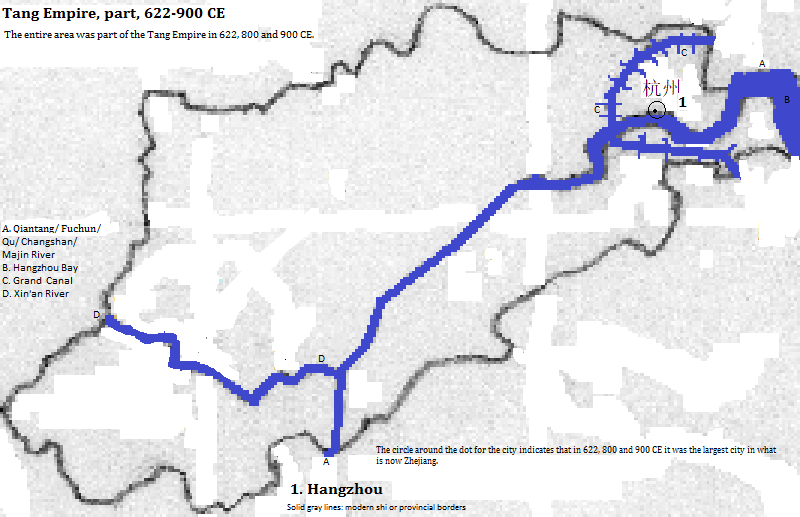
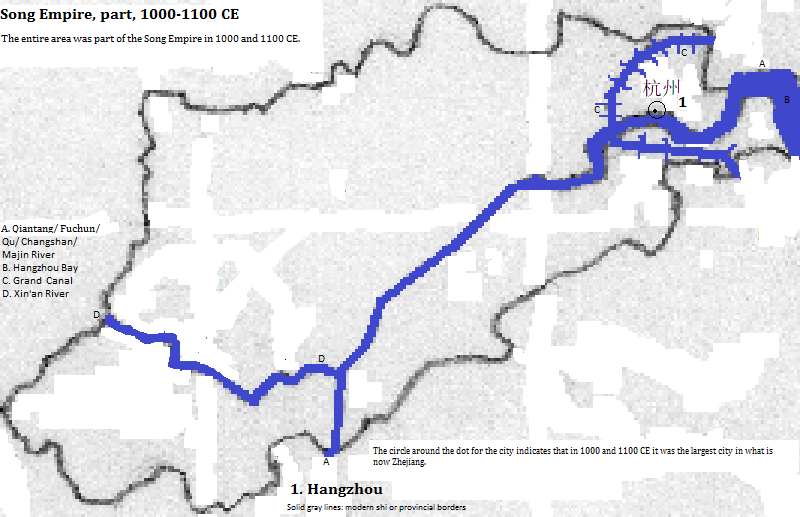
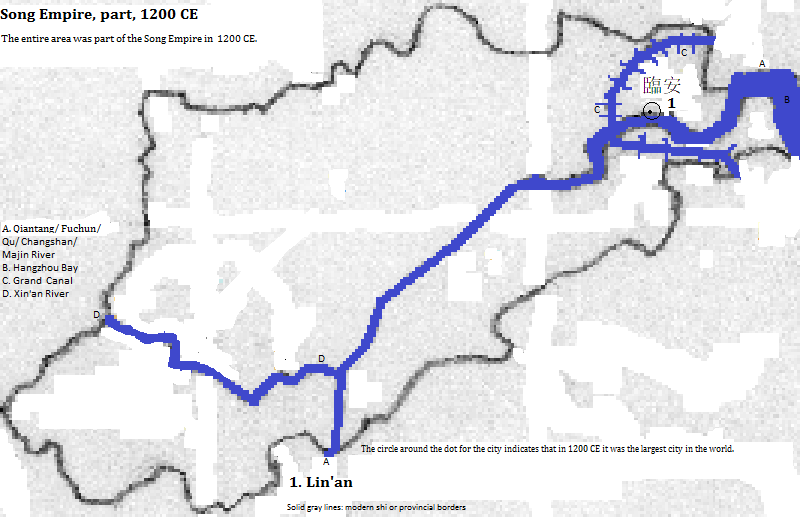
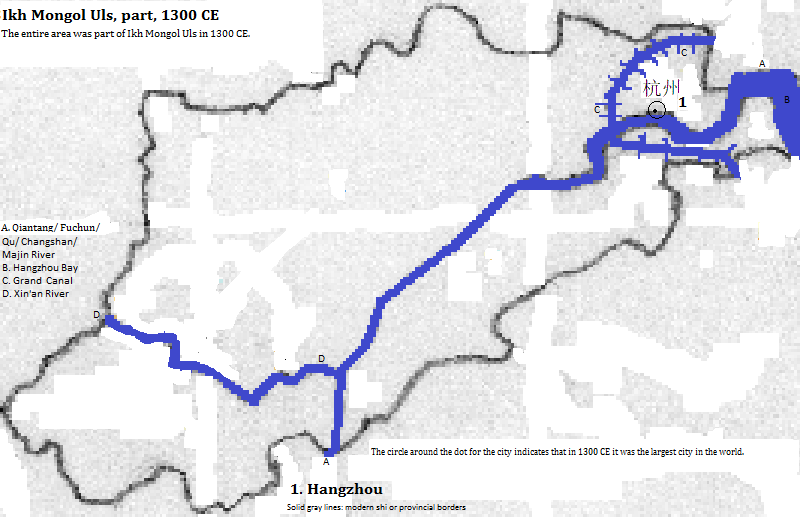
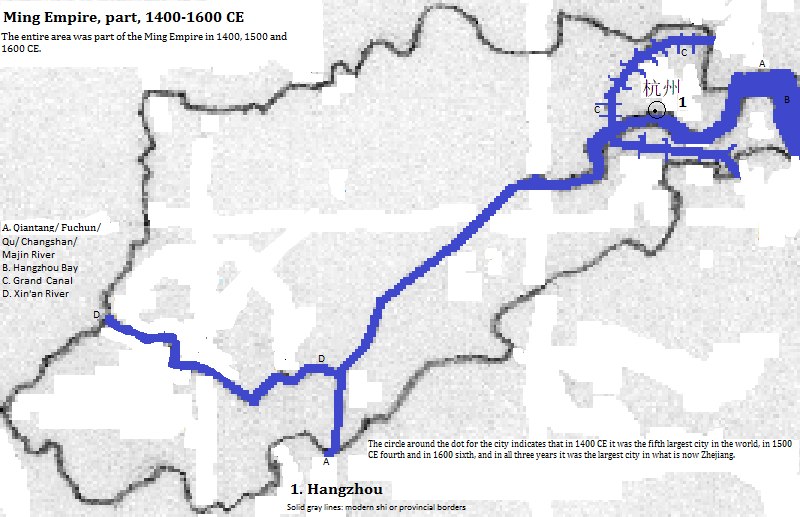
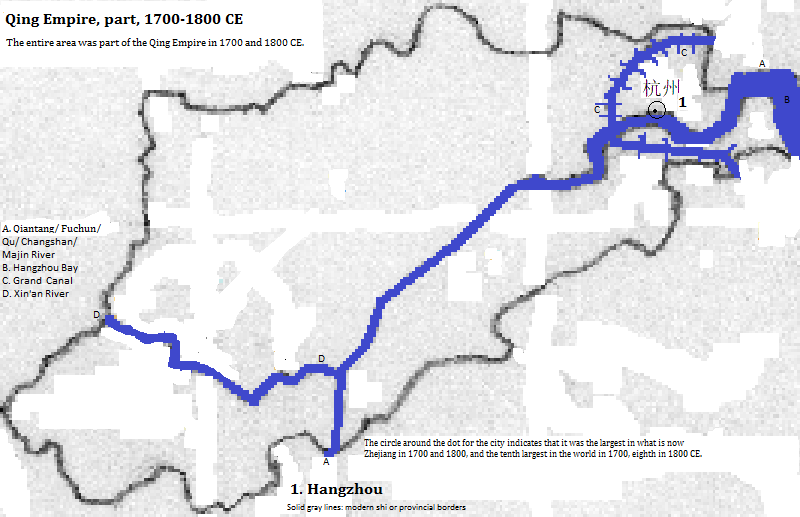
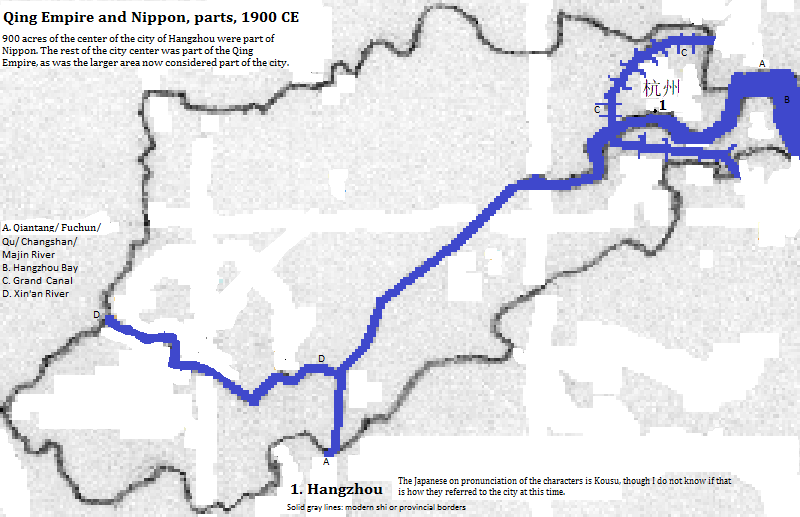

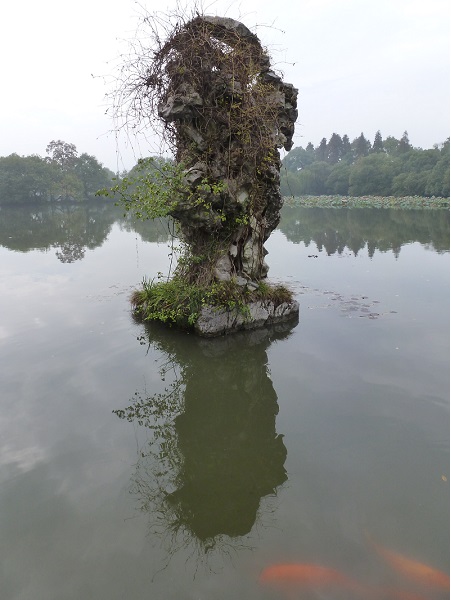
West Lake, 湖州 (Hángzhōu), 浙江 (Zhèjiāng) Province, 中华 (Zhōnghuá) People's Republic
Footnotes
1. Hángzhōu or Hang-chou or Hangjou in transliterated Pŭtōnghuà Chinese. It is also called Hangchow (former postal designation based on the Nanjing dialect). The first character is used only in naming people and places. The second refers to an administrative division, usually translated as either province, prefecture or county. In the Hangzhou dialect (Wu dialect group) it transliterates as Ɦaŋtsei.
2. Zhèjiāng or Che-Chiang or Jejyang in transliterated Pŭtōnghuà Chinese. It is also called Chekiang (former postal designation based on the Nanjing dialect). The first character is a phonetic marker coupled with the water radical. In reconstructed Old Chinese it was pronounced like tet, and was a proto-Wu term for the Yue people according to https://en.wikipedia.org/wiki/Zhejiang, accessed August 10, 2016. The second character means river.
3. Zhōnghuá or Chung-hua or Junghwa in transliterated Pŭtōnghuà Chinese. The first character means central and the second means Chinese/ illustrious/ flowery. China is its English name. In the Wu dialect group it transliterates as Tsonkoh.
4. I do not know the name used at the time.
5. This excludes two counties (xian), and Jiande county-level city (shi), which is cut off by the two counties from the rest of the prefecture. It includes all the districts (qu) and Lin-an county-level city (shi). The amount of the exclusion also comes from the 2010 census.
6. Emporis.com, accessed September 27, 2016.
7. UNESCO mentions the Hangzhou Ziaoshan-Shaowing Section of the Zhedong Canal and the Jiazing-Hanzhou section of the Jiangnan Canal, both of which are partly within 湖州 (Hángzhōu).
8. http://whc.unesco.org/en/list/1334, accessed September 27, 2016.
9. My list of tourist attractions for the province came from a combination of two sources: first, http://www.china.org.cn/top10/2012-06/04/content_25538813.htm (Zhejiang tourism, accessed August 3, 2016)--first five only (rest errored out, which were really the top five as the list was backward-ordered)--but I eliminated the first one (that is number ten by rank) since I only wished for nine total; and second, https://www.tripadvisor.com/Attractions-g297468-Activities-Zhejiang.html--top five, accessed August 3, 2016.
10. https://en.wikipedia.org/wiki/List_of_the_busiest_airports_in_China, accessed August 3, 2016: 2015 table of top 50.
11. Tertius Chandler, Four Thousand Years of Urban Growth, 2nd ed. (The Edwin Mellen Press, 1987), "Tables of World's Largest Cities". According to Chandler in 100 CE was small er than Jullundur, which was smaller than Tosali, which was smaller than Angora, which had 34 thousand residents. It was largest than Changsha, which was larger than Ayodhya, which was larger than Tunhuang, which had 32 thousand residents. In 100, 622, 800, 900, 1000, 1100, 1200, 1300, 1400, 1500, 1600, 1700 and 1800 it was the largest city in what is now the province, and larger than anything in what is now 上海 (Shànghăi) Municipality. In 1200 and 1300 it was the largest city in the world, fourth largest in 1500, fifth in 1400, sixth in 1600, eighth in 1800 and tenth in 1700. In 1200 it was called 臨安 (Lín'ān). In today's simplified characters that would be 临安. It transliterates from Pŭtōnghuà Chinese as Lín'ān or Lin-an or Linan. The first character has meanings clustered about the concept of 'nearly'; the second character is about peacefulness. The population for 1900 includes both sovereign zones.
12. https://www.citypopulation.de/php/china-zhejiang-admin.php (accessed Aug. 2, 2016) provided the prefectural and sub-prefectural populations for 2000. https://en.wikipedia.org/wiki/List_of_administrative_divisions_of_Zhejiang, accessed on the same date provided the list of administrative changes 2000 to date, specifically that Fuyang County was upgraded to Fuyang District. Adding Fuyang District to the list of exclusions brings the metropolitan population down to 5,017 million, with the shi without exclusions having 6,879 million in 2000 CE.











